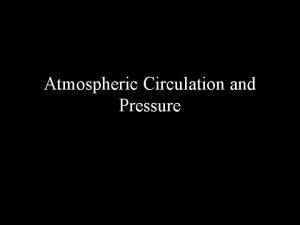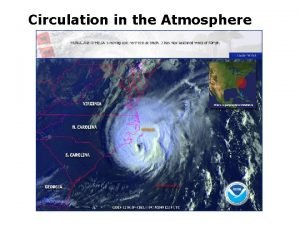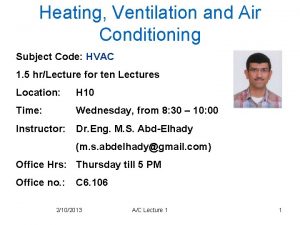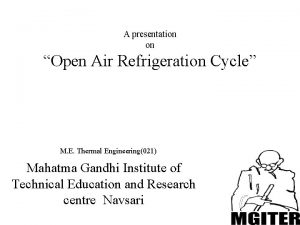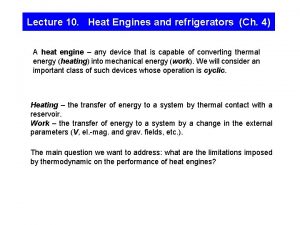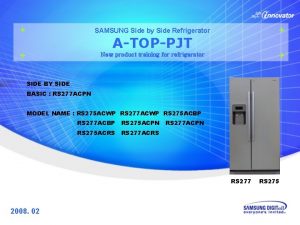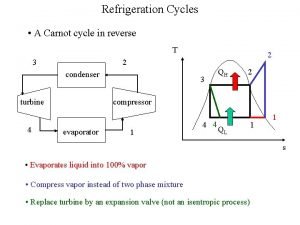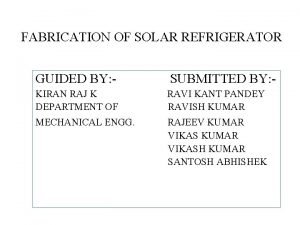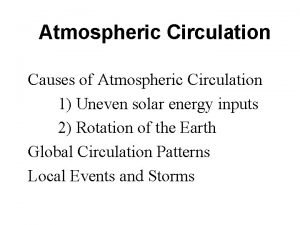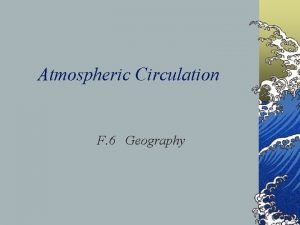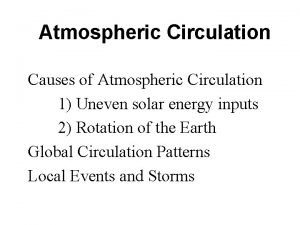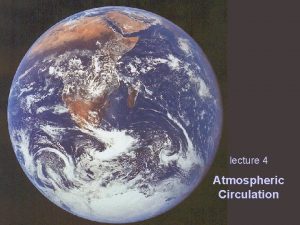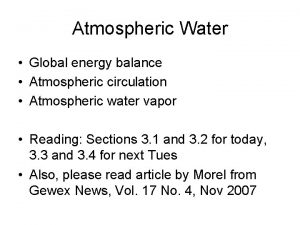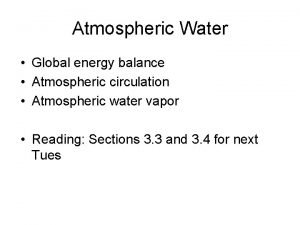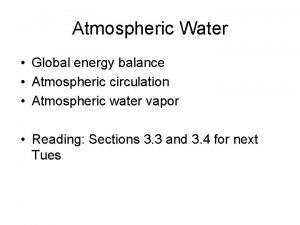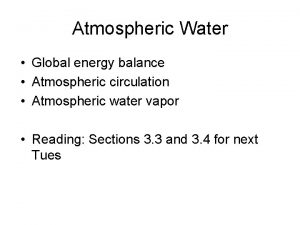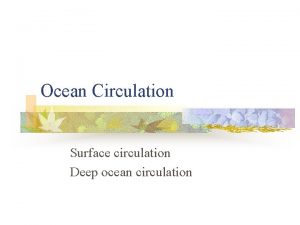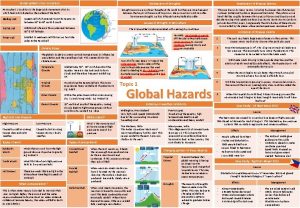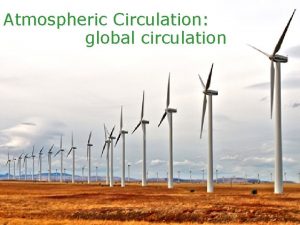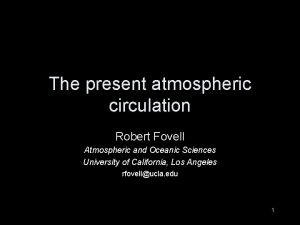Atmospheric Circulation Thermal Structure and the Mesospheric Refrigerator

















- Slides: 17

Atmospheric Circulation: Thermal Structure and the Mesospheric Refrigerator How do Atmospheric Gravity Waves couple to the mean circulation to produce the coldest place on earth? Jonathan S. Friedman with particular thanks to C. Y. She and S. Harrell (using lots of “borrowed” materials) 6 June 2013 Mesospheric Refrigerator NAIC Arecibo Observatory

Atmospheric Structure Relatively inert, dynamically unstable Dynamically Stable, rising air does not penetrate easily, but waves can propagate. Weather & orography Mesospheric Refrigerator NAIC Arecibo Observatory

At the mesopause level (~80 km) the summer polar region is on the average 70 -80°C colder than the winter polar region. Such a temperature distribution is far from radiative equilibrium and clearly must be dynamically maintained by adiabatic cooling (heating) due to ascent (subsidence) in the summer (winter) hemisphere. (Holten, J. Atmos. Sci. , 1982) Mesospheric Refrigerator NAIC Arecibo Observatory

Winter Mesospheric Refrigerator NAIC Arecibo Observatory

What’s the problem? • • • Problem: The thermal structure of the stratosphere/mesosphere is far from radiative equilibrium ⇒ mechanical forcing is required. Complication: Simple upwelling in the sunlit summer polar region provides insufficient forcing to induce the non-intuitive structure. Which raises the question: What drives the refrigeration process and how? Mesospheric Refrigerator NAIC Arecibo Observatory

Definitions • Radiative Heating/Cooling Temperature change by absorption/emission of radiation • Atmospheric Gravity Waves Fluctuations where gravity is the restoring force • Geostrophic Winds generated and controlled by pressure gradients and the coriolis force • Coriolis “Force” Deflection in the motion of an object moving in a rotating frame of reference. Actually a statement of conservation of angular momentum. Refrigerator A system of dynamical cooling through expansion and compression. Mesospheric Refrigerator NAIC Arecibo Observatory

What Contributes to Circulation? • Solar Tides » Surface heating » Ozone absorption of Solar UV • Rotation of the Earth — Coriolis Force • Geostrophic winds (pressure gradients) • Atmospheric Gravity Waves • Planetary Waves Mesospheric Refrigerator NAIC Arecibo Observatory

Starting with tropospheric circulation http: //www. ux 1. eiu. edu/~cfjps/1400/circulation. html Mesospheric Refrigerator NAIC Arecibo Observatory

Stratospheric Circulation • • • Hadley Cell Ferrel Cell Polar Cell Mesospheric Refrigerator NAIC Arecibo Observatory

Gravity Waves • Atmospheric pressure waves produced by processes such as convection (thunder storms), winds passing over mountains, etc. • Amplitude increases as it propagates upwards to thinner atmosphere. • Can carry large amounts of energy, which is deposited where the wave breaks, affecting wind flow. Video, courtesy Dave Fritts Courtesy: Paul Castleberg Mesospheric Refrigerator NAIC Arecibo Observatory

Mesospheric Refrigerator NAIC Arecibo Observatory

Mesospheric Refrigerator NAIC Arecibo Observatory

If the relative velocity between the wave source and wind is fast enough. . . Mesospheric Refrigerator NAIC Arecibo Observatory

Mesospheric Refrigerator NAIC Arecibo Observatory

In the summer mesosphere, gravity waves break down the zonal wind. The resulting momentum is poleward towards the winter pole. The result is high winter pole winds and warmer temperatures at 87 km. Mesospheric Refrigerator NAIC Arecibo Observatory

Conclusions • • • The summer mesopause, at between 85 & 90 km, is the coldest place on earth. The solstice temperature structure in the upper mesosphere is inverted from the intuitive (radiatively controlled) form. This implies dynamical heat transfer » a mesospheric refrigerator. The evaporator/compressor cycle is driven by gravity waves, which break down the geostropic summer zonal wind flow and enhance the winter zonal flow. The result is pole-to-pole airflow that produces the observed thermal structure. Mesospheric Refrigerator NAIC Arecibo Observatory

some References • • • Andrews, D. G. , J. R. Holton, and C. B. Leovy, Middle Atmospheric Dynamics, Academic Press, San Diego, CA, 1987. Fritts, D. C. and R. A. Vincent (1987), Mesospheric momentum flux studies at Adelaide, Australia: Observations and a gravity-wave–tidal interaction model, J. Atmos. Sci, 44 (3), 605– 619. Gardner, C. S. and W. Yang (1998), Measurements of the dynamical cooling rate associated with the vertical transport of heat by dissipating gravity waves in the mesopause region at the Starfire Optical Range, New Mexico, J. Geophys. Res. , 103, 16, 909– 16, 926. Holton, J. R. and M. J. Alexander (2000), The role of waves in the transport circulation of the middle atmosphere, in Atmospheric Science Across the Stratopause, edited by D. E. Siskind, S. L. Ekermann, and M. E. Summers, Geophys. Monogr. Ser. , pp. 21– 35, American Geophysical Union. Concept of a two-level mesopause: Support through new lidar observations, J. Geophys. Res. , 103, 5855– 5864. Mesospheric Refrigerator NAIC Arecibo Observatory
 Single circulation and double circulation
Single circulation and double circulation Single circulation and double circulation
Single circulation and double circulation Alveolus
Alveolus Single cell model of atmospheric circulation
Single cell model of atmospheric circulation Single cell model of atmospheric circulation
Single cell model of atmospheric circulation Atmospheric circulation
Atmospheric circulation Tri cellular model of atmospheric circulation upsc
Tri cellular model of atmospheric circulation upsc Chapter 5 thermal energy answer key
Chapter 5 thermal energy answer key Thermal transfer vs direct thermal printing
Thermal transfer vs direct thermal printing Refrigeration
Refrigeration Refrigeration cycle ts diagram
Refrigeration cycle ts diagram Difference between refrigerator and heat pump
Difference between refrigerator and heat pump The refrigerator and pantry are the major items here
The refrigerator and pantry are the major items here Difference between heat engine and refrigerator
Difference between heat engine and refrigerator 435rfbyy
435rfbyy Cycle carnot
Cycle carnot Refrigeration cycle thermodynamics
Refrigeration cycle thermodynamics Submitted by and guided by
Submitted by and guided by




